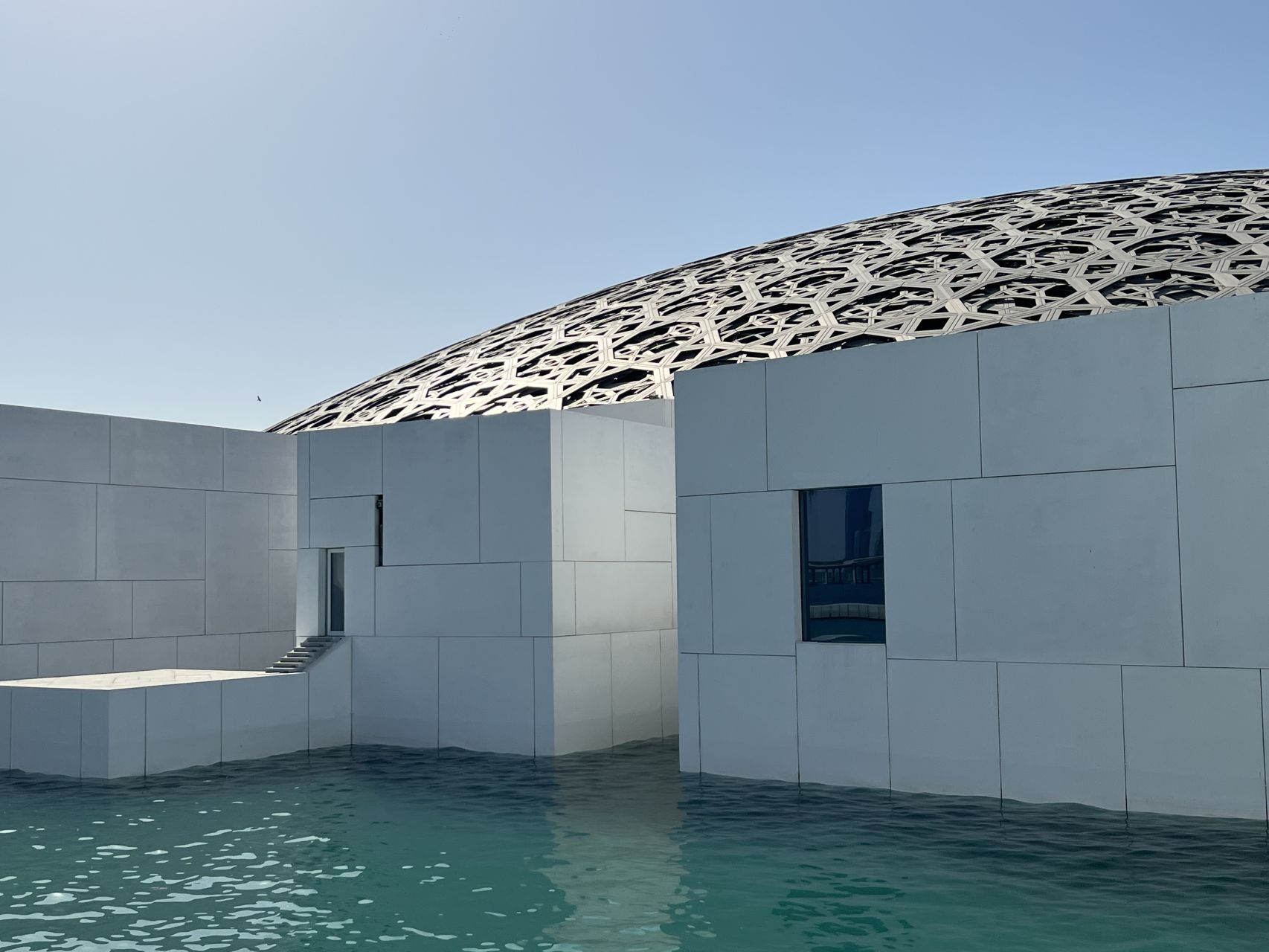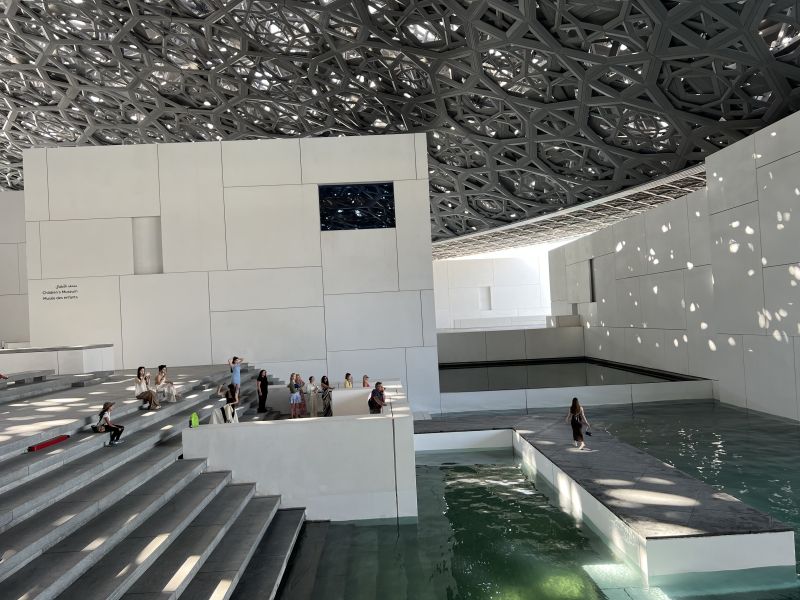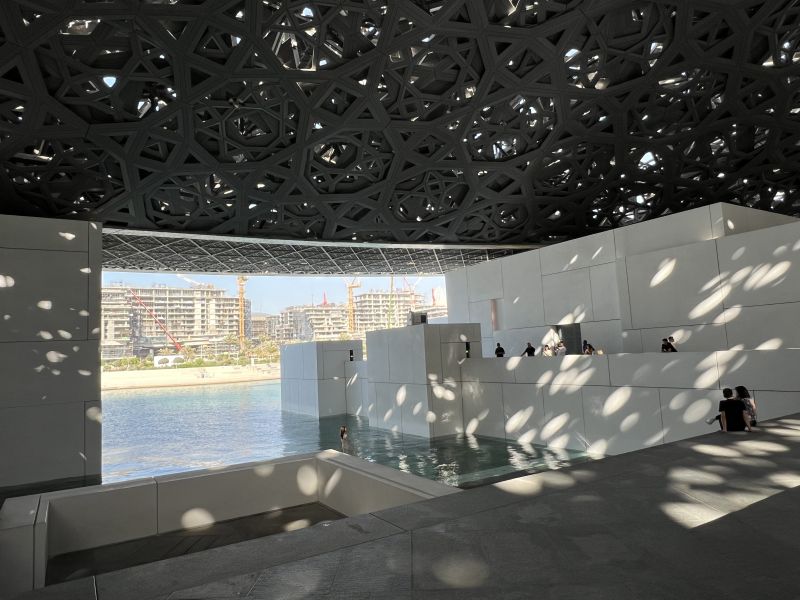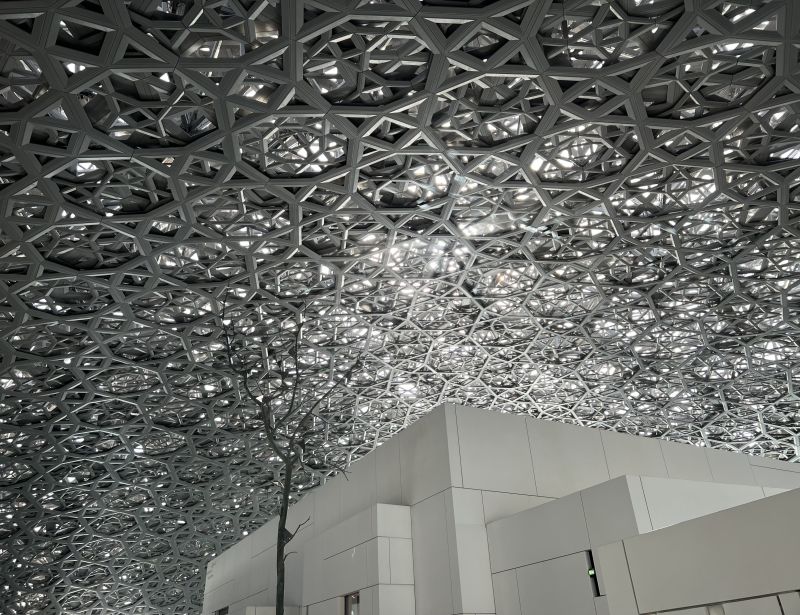
Set on the waters of the Persian Gulf, the Louvre Abu Dhabi glows beneath a celestial dome designed by Jean Nouvel. Bathed in filtered light and shimmering sea reflections, this one-of-a-kind museum offers a sensory experience where art seems to float on the horizon.
Just off the coast of Abu Dhabi, at the entrance to Saadiyat Island, a steel dome perforated with 7,850 geometric stars filters sunlight like a futuristic mashrabiya. Designed by Jean Nouvel, this architectural marvel shelters a museum unlike any other in the world: the Louvre Abu Dhabi. Born of an unprecedented partnership between France and the United Arab Emirates, the museum represents a bold and successful reimagining of the universal museum.
Even before stepping into its galleries, the Louvre Abu Dhabi delivers a sensory encounter. Floating above the sea like an architectural mirage, it rises from the water in luminous white — a cultural archipelago slowly emerging from the desert sands. Nouvel’s design is more than a structure; it’s a living metaphor, a statement of both delicacy and strength.

The dome of Louvre Abu Dhabi: a play of light and poetry. © This is Beirut
The building appears to be floating on the Persian Gulf. Visitors cross bridges over the water to enter, as though stepping into a sanctuary, detached from the world. The monumental dome, 180 meters in diameter and the visual signature of the museum, does not rest on the museum’s walls but on eight hidden pillars, creating the illusion of it being suspended in mid-air. This openwork dome, a constellation of geometric patterns inspired by Islamic tradition, casts a play of light and shadow known by Nouvel as the "rain of light" — a soft, ever-changing solar shower that accompanies the visitor’s movements, its intensity shifting with the time of day.

The Louvre Abu Dhabi: a frame within the frame — where architecture becomes perspective.© This is Beirut
The effect is mesmerizing. Between shadow and light, water and stone, silence and resonance, the architecture evokes a secular spirituality. The museum does not impose itself; it fades into its surroundings, merging with the sky and sea, inviting one to slow down, to contemplate, and to listen to the space. Jean Nouvel, creator of the Arab World Institute in Paris, presents a total work of art, where the envelope becomes a narrative, and the structure itself embodies the museum's purpose. A dialogue between civilizations, set in a place at the crossroads of worlds.

The Louvre Abu Dhabi: a rain of light beneath the celestial dome.© This is Beirut
A Boundless Museography
Unlike traditional museums, which categorize works by schools, civilizations, or historical periods, the Louvre Abu Dhabi offers a thematic, cross-cultural approach. Its galleries don’t simply place cultures side by side; they foster a dialogue between them. In a single room, a Greco-Roman bust sits alongside a Chinese Buddha, a Quranic manuscript, a Flemish Madonna and Child, and an African mask. The goal isn’t to present isolated masterpieces, but to highlight the universal nature of human creativity across different times and places.
This curatorial approach reflects a political vision of culture. It challenges civilizational hierarchies and nationalist interpretations of art, affirming instead that all cultures are interconnected, that exchange precedes division, and that humanity’s story is one of movement and shared influence. What is often referred to in museology as "cross-display" here becomes a statement of tolerance and openness.
The name of the institution itself sparked considerable debate: "Louvre" in Abu Dhabi? The use of the name was seen in Paris as a commercial concession. However, the partnership is based on a rigorous agreement. For 30 years, the Louvre Abu Dhabi benefits from rotating loans of artworks, scientific support, and the right to use the name. In return, it helps finance its French partner institutions and contributes to the development of a new global museum hub.

Black-and-white reproduction of the Mona Lisa at the entrance of Louvre Abu Dhabi, paying tribute to Leonardo da Vinci’s masterpiece. © This is Beirut
This cultural cooperation agreement has allowed Abu Dhabi to house an impressively diverse collection: ancient artifacts, medieval icons, Renaissance masterpieces, and modern and contemporary art. The museum also curates its own collection, with a resolutely international acquisition policy. The goal? To become a world-class museum rooted in the region, rather than a mere Western outpost.

Replica of an Olmec colossal head at the entrance of Louvre Abu Dhabi — a striking tribute to Mesoamerican monumental art, placed even before the museum’s reception area. © This is Beirut
The Louvre Abu Dhabi has developed a program of temporary exhibitions in collaboration with French museums. These exhibitions, ranging from Rembrandt to Mondrian, and exploring Islamic worlds, delve into highly narrative themes. The curatorial approach focuses on intelligent mediation, immersive experiences, and accessible storytelling without oversimplification. The aim is to foster a new kind of familiarity with art in a region where the museum experience is still taking shape.
Beyond art, the Louvre Abu Dhabi is a tool of soft power. It embodies the UAE's strategy to become a cultural influencer in a region still largely defined by military and religious influence. Alongside NYU Abu Dhabi and the emerging museums of Saadiyat Island, it positions the Emirate within a narrative of modernity, tolerance, and international openness.
Thus, it becomes a place of symbolic neutrality, where civilizations meet without hierarchy. It appeals to the West, reassures neighboring countries, and captivates the curious. Its silent diplomacy relies not on speeches, but on masterpieces—the act of placing a Quran, a Torah, and a Bible side by side. An image that speaks louder than any treaty.


Comments